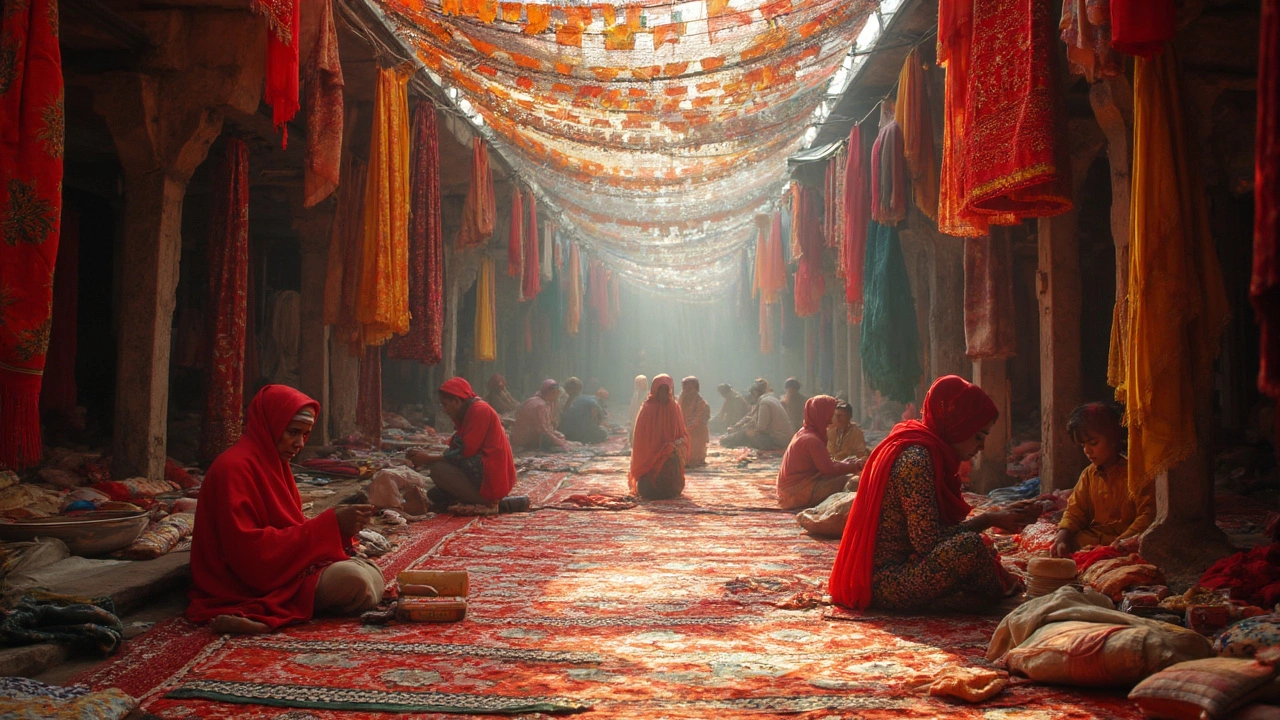India is one of the biggest players in the global textile industry, and it's not just for show. The country's textile manufacturing sector is home to countless companies, each weaving its own story in the vast fabric of this industry. But if you've ever wondered just how many textile manufacturing companies are scattered across this vibrant nation, you're in the right place.
The textile industry in India is massive, with roots going back centuries. It’s the second-largest employer in the country, right after agriculture. From tiny homegrown businesses to sprawling corporate giants, the diversity and scale are astounding. So, just how many companies are we talking about? Recent data suggests there are over 100,000 textile manufacturing units operating in India.
This number includes a mix of small-scale industries, which make up a significant portion, and large corporations that dominate the exports market. What's fascinating is the sheer volume of textiles produced here—cotton, silk, wool, and synthetics—each diverse in its production process and market demand.
- Overview of the Textile Industry in India
- Number of Textile Companies
- Regional Distribution and Hubs
- Economic Impact of Textile Manufacturing
- Trends and Innovations
- Navigating the Industry: Tips and Insights
Overview of the Textile Industry in India
The textile industry in India isn't just a business; it's a significant part of the country's history and culture. As one of the largest manufacturing sectors, textile companies in India contribute around 4% to the country's GDP. That's pretty impressive, right?
India’s textile manufacturing covers everything from raw material production to finished goods. We're talking about cotton fields in Gujarat, silk weaving in Karnataka, and high-tech garment factories in Tamil Nadu. Each region has its own unique flavor and focus, which all together make India a major global hub for textile production.
Historical Significance
Textiles are woven into the very fiber of India's past, quite literally. This sector has been a backbone of economic activity for centuries, with roots dating back to the ancient Indus Valley Civilization. Once a major player in the handloom industry, India adapted over time, growing into a massive modern manufacturing powerhouse.
Current Landscape
Today, the Indian textile industry is a blend of traditional craftsmanship and modern technology. It employs millions, providing jobs not just in manufacturing, but also in fashion design, marketing, and retail. The sector exports billions worth of goods annually, reaching markets in the US, Europe, and beyond.
Are you curious about the specifics? I've got you covered. Here's some quick data:
| Category | Contribution (%) |
|---|---|
| Gross Domestic Product (GDP) | 4% |
| Total Exports | 13% |
| Industrial Production | 14% |
As you can see, the economic impact is massive, cementing its role as a critical part of the national economy. With government initiatives, like the 'Make in India' campaign, there's a push to make this industry even more competitive on a global stage.
From big brands to small textile manufacturers, the ecosystem is vibrant and ripe with opportunities for growth and innovation. It's like a weaving of history and the future — pretty exciting if you ask me.
Number of Textile Companies
When it comes to the textile companies in India, the numbers can be quite staggering. We're talking about over 100,000 textile manufacturing units spread across the nation. These companies range from small operations to large-scale production houses. This scale of operation isn't just a testament to the industry's reach but also its resilience in adapting to changes over time.
The Spectrum: Small to Large
Most of these companies are part of the small and medium enterprises (SME) category. In fact, about 80% are small-scale businesses that manage to keep the local economies buzzing. Meanwhile, the big fish, accounting for roughly 10,000 companies, are involved in large-scale production and heavily contribute to exports, especially of garments and cotton products.Industry Clusters and Hubs
Textile manufacturing isn't just randomly spread out. It's clustered in certain regions known for specific types of textiles. For instance, Surat in Gujarat is famous for synthetic textiles, while Tiruppur in Tamil Nadu is renowned for knitwear production. These clusters boost efficiency and help grow specialized skills within local communities.Impact of Recent Policies
Government initiatives and policies have further increased the number of companies, thanks in part to schemes like 'Make in India' which support manufacturers with subsidies and other benefits. The aim is to boost production and enhance the export market, making Indian textiles even more competitive globally.Such diversity and adaptability showcase why the Indian textile industry continues to be a powerhouse on the world stage. Whether you're an investor, a budding entrepreneur, or just curious about the industry, understanding these numbers offers a clearer picture of the scale and scope of textile manufacturers in India.
Regional Distribution and Hubs
You can't talk about textile manufacturing in India without diving into its vibrant regional hubs. These areas aren't just the backbone of the industry; they're its heart and soul. A trip through India's textile corridors reveals where the action is truly happening.
Key Textile Regions
Gujarat: This state is a powerhouse in textile production. Ahmedabad, known as the 'Manchester of India,' is renowned for its cotton textiles. The strategic location and established cotton industry make Gujarat a leader in the field.
Tamil Nadu: Down south, Tamil Nadu stands tall with its knitting and apparel industries. Places like Tiruppur and Coimbatore are buzzing with activities related to textiles, especially knitwear exports. It's a haven for those eyeing the garments sector.
Maharashtra: Home to major cities like Mumbai and Pune, Maharashtra plays a significant role in textile manufacturing. The state is known for its spinning mills and is a major hub for synthetic textiles.
Emerging Hubs
While traditional hubs dominate, some emerging regions are catching up fast:
- Haryana: Known for its garment factories, especially in the NCR belt, contributing significantly to exports.
- West Bengal: With a rich textile heritage, Kolkata and its surroundings are focusing more on apparels and jute products.
Recognizing these hubs matters, especially if you’re thinking of diving into this industry. Knowing where production is clustered helps businesses make strategic decisions.
Here's a snapshot of some numbers:
| State | Key City | Focus Area |
|---|---|---|
| Gujarat | Ahmedabad | Cotton Textiles |
| Tamil Nadu | Tiruppur | Knitwear |
| Maharashtra | Mumbai | Synthetics |
| Haryana | Gurgaon | Garments |
In short, India’s textile story is spread across these bustling hubs, each weaving its unique tale and contributing to the textile tapestry of the country. It's all about being where the fabric of innovation and tradition meet.

Economic Impact of Textile Manufacturing
When it comes to boosting an economy, few industries pack quite the punch of textile manufacturing. In India, this sector is a vital contributor to both employment and Gross Domestic Product (GDP). With over 45 million people employed directly and another 60 million in allied industries, it's a cornerstone of livelihood across the country.
The textile sector contributes around 2% to India’s GDP and accounts for about 12% of the country's export earnings. A sizeable chunk, right? Well, it only gets more interesting when you know that this industry is responsible for nearly 7% of the total industry output in terms of value.
Export Powerhouse
India exports textiles to over 150 countries. Ranking high among the world's textile exporters, India is a key player in the global arena. From cotton to garments, the reach and influence of Indian textiles can be seen in fashion markets worldwide.
"The textile industry is a vital cog in the wheel of the Indian economy, sustaining millions and contributing significantly to the nation's growth," said Rajeev Goyal, a prominent textile industry strategist.
Impact on Rural Economy
Interestingly, a large part of India's textile production happens in rural areas. This decentralization allows the industry to uplift rural economies by providing employment opportunities. It helps in keeping traditional craftsmanship alive and has played a vital role in women's empowerment in these regions.
Contribution to Innovation
The economic impact doesn't just stop at numbers. The Indian textile industry is leading the charge in innovations, from sustainable fabrics to high-tech production processes. Smart textiles and eco-friendly production methods are becoming the norm, driven by the demands of both domestic and international markets.
Here's a quick snapshot of some key statistics:
| Key Metric | Value |
|---|---|
| Direct Employment | 45 Million |
| GDP Contribution | 2% |
| Export Earnings Contribution | 12% |
| Export Countries | 150+ |
In summary, the economic impact of textile manufacturing is vast and varied. It's a driver of growth, innovation, and social change, illustrating its significance beyond mere fabric production.
Trends and Innovations
Let’s face it, the textile industry is not just about pretty fabrics anymore. India’s textile manufacturing sector has seen some major shifts driven by technology and changing consumer preferences. Textile companies in India are taking strides to stay ahead in this fast-paced world.
Tech to the Rescue
Technology is the biggest game-changer. Automation and digitization have streamlined many processes, making production faster and more efficient. Many companies are using AI algorithms to predict fashion trends, which helps them design and produce what the market craves. Imagine computers picking out the next hit fabric before we've even thought about it!
Going Green
Sustainability is a buzzword that’s not going away. Textile manufacturers are making efforts to reduce their carbon footprint. From using organic raw materials to recycling water and adopting cleaner production techniques, the move toward greener manufacturing is evident. Many consumers now prefer brands that are eco-friendly, pushing companies to rethink their strategies.
Smart Textiles
Smart textiles—fabrics that incorporate digital elements—are creating waves. Think about clothing that can monitor heart rates or adjust temperature based on weather conditions. Pretty sci-fi, right? This innovation is opening up new markets for textile manufacturers, particularly in sports and healthcare.
Digital Platforms
Gone are the days when supply chain management was a complete headache. Digital platforms now help companies track everything from raw material procurement to final delivery. It’s made the process transparent and efficient, allowing companies to reduce delays and costs.
Global Collaboration
Many Indian textile companies are forming partnerships with global brands. It’s a win-win: Indian firms get access to new markets, and international brands benefit from the quality and cost-effectiveness of Indian textiles. These collaborations are fueling growth and innovation.
To keep up with these trends and stay competitive, companies need to adapt quickly. The textile landscape is changing, and those who embrace these trends will be the ones who succeed.
Navigating the Industry: Tips and Insights
Getting a handle on the vast Indian textile industry can be a bit like trying to find a needle in a haystack. But, no worries. We've got some tips to help you make sense of it all. Whether you're an aspiring entrepreneur, an investor, or just curious, these insights should help you find your footing.
Understanding Regional Hubs
The geographic spread of textile manufacturers is essential to navigate efficiently. Major hubs like Gujarat, Maharashtra, and Tamil Nadu lead the pack. For instance, Surat in Gujarat is well-known for its synthetic textiles, while Tirupur in Tamil Nadu is a major hub for knitwear. Knowing these hubs can help pinpoint opportunities for collaboration or investment.
Keeping an Eye on Trends
The industry is rapidly evolving with trends such as eco-friendly textiles and smart fabrics coming to the forefront. Indian manufacturers are increasingly adopting sustainable practices, like using organic cotton and recycling processes, to meet global demand. Keeping an ear to the ground for such trends can help you stay ahead of the curve.
Networking and Building Relationships
In an industry interwoven with tradition, relationships are key. Attending trade fairs, like the India International Textile Machinery Exhibitions, can provide valuable networking opportunities. Building a network can open doors to collaborations and insights into market dynamics.
Leveraging Government Initiatives
The Indian government has launched several initiatives to boost this sector, including the Technology Upgradation Fund Scheme (TUFS) to help with capital investments. Being aware of and leveraging such schemes can significantly reduce entry barriers and operational costs.
Data and Strategy
Finally, there’s nothing like solid data to back up your strategies. Market research reports are available and can provide insights into consumer behavior and market size. Understanding this data allows for informed decision-making, whether you're entering the market or expanding an existing business.
Here’s a little snapshot of some of the largest companies in the industry and their contributions:
| Company | Headquarters | Main Products |
|---|---|---|
| Arvind Limited | Ahmedabad | Denim, Shirting |
| Vardhman Textiles | Ludhiana | Yarn, Fabric |











Write a comment